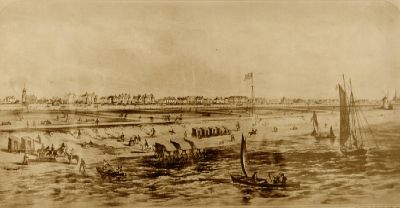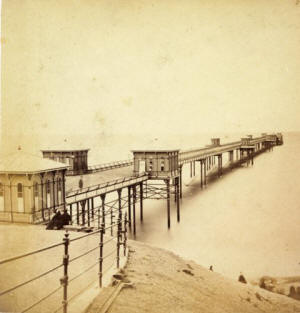The Preston Guardian Saturday, June 11, 1864
SCREWING THE FIRST PILE OF THE LYTHAM PIER.
In noticing, last week, the building of the Shard Bridge over
the Wyre, we referred to the other public works in progress, or contemplated, in
the Fylde, and among them to the pier which it is proposed to erect at Lytham. The
want of some such structure has been felt at this favourite watering place, but
doubts were entertained whether, if one were erected, it would "pay." When,
however, one had been opened at Blackpool, and it was found that it was not only
useful and ornamental, but was commercially a success a movement was commenced for
the erection of a pier at Lytham.

Although Lytham is not so populous as Blackpool, and has not so
large an influx of visitors for, on some account or other, the railway authorities
do not, either in the matter of fares, or excursion trips favour Lytham as they do
the sister watering place, it was considered that the longer season which Lytham
has, and the less cost which a pier could be erected for at Lytham, would make up
for the advantages which Blackpool has in the number of visitors.
When the project was fairly matured the whole of the proposed
shares were taken up without as much as the issue of a prospectus or the
publication of a single advertisement. The share list having been completed, the
provisional directors placed themselves in communication with Eugenius Birch, Esq.,
C.E., of Parliament-street, London, the engineer of the Blackpool and other piers,
and he submitted a design which met with the approval of the directors who invited
tenders for the construction of the work.
That of Messrs. Laidlaw and Sons, of Glasgow, Edinburgh, and
London, the contractors for the erection of the Blackpool pier, and also for those
at Deal, Brighton West, Eastbourne, and Hastings, all of which were designed by Mr-
Birch, was the lowest, and it was accepted, and directions were given for the work
to be proceeded with without loss of time.
The various preliminaries that had to be settled were adjusted
without difficulty. The Admiralty were satisfied with the plans, the Duchy of
Lancaster conceded the requisite sanction, the Ribble Navigation Company withdrew
their threatened opposition, Colonel Clifton granted, without demur and for a
merely nominal acknowledgment, the requisite land, the Board of Trade facilitated
all the formalities in connection with their department, and the act of parliament
incorporating the company and sanctioning the work is passing through the necessary
stages without opposition. It was at first thought that the pier might be completed
by the 1st of July, but various circumstances occurred to prevent the work being
commenced as early as was anticipate; it is now expected that it will be the middle
of August before the structure can be "opened” to the public. No doubt is, however,
entertained that it will be completed by the meeting of the Royal North Lancashire
Agricultural Association, which is this year to be held at Lytham, and which is to
be attended with great éclat.
The pier will be in a line with Dicconson-terrace, and, when
completed, it will be an ornament to the place as well as a convenience to
visitors- It will be 914 feet long, extending from the promenade to low water mark,
at neap tides and to within 150 feet of low water mark at spring tides. The pier
will, mainly, be on the same principle as the one at Blackpool. It will be built on
piles, hollow cylindrical columns of cast iron. To the base of each column is
attached one helix of a screw. This is screwed four feet six inches into the clay,
below the sand. The piles are in clusters and are placed at every sixty-six feet.
On these piles wrought-iron latticed girders, with ornamental entablatures will be
fixed. The clusters of the columns or piles are braced together, forming equal
triangular trusses. Every 250 feet along the pier there will be a recess on each
side, and in each there will be an ornamental lamp lighted with gas.
At the head of the pier will be waiting rooms for visitors. Off
the head of the pier, and a distinct structure from it, will be a dolphin or
landing stage for the accommodation of passengers arriving at or leaving Lytham by
steamers. The dolphin will communicate with the pier by a staircase. The entrance
to the pier will be by ornamental gates, somewhat of the style and character of
those at the new pier at Brighton West, and much more elegant than those of
Blackpool pier.
|

|
The entrance to the Lytham pier will also be more imposing than
that at Blackpool, as instead of the steep descent from the promenade at the latter
place, there will be a slight ascent, so that the entrance will be seen to
advantage a considerable distance. There will be a tollhouse, also of an ornamental
character. Within the gates there will be a circular area of 150 feet wide; then
the pier proper will be 18 feet wide, except opposite the recesses where it will
be, of course, of greater width. A seat will be fixed on each side, the entire
length of the pier, for the accommodation of visitors. The structure will be
entirely of iron, except the roadway, which will he planked.
It was determined to have no public demonstration, in connection
with the pier, until its completion. On the occasion, however, of commencing the
work, on Wednesday last, the directors of the company screwed the first pile. About
sixty or seventy tons of iron work for the pier arrived at Lytham last week, and as
the columns and other component parts of the structure have since lain on the
beach, they have attracted much attention among the visitors and residents, which
was much increased on Wednesday last, when the workmen commenced their preparations
in earnest for placing the iron work in its destination.
It was arranged that the first pile should be "screwed." at
half-past three o'clock in the afternoon, and at that time a large number of
persons assembled to witness the ceremony. The day was very fine, and the scene was
enlivened by the performances of the Blackpool Brass Band. An excavation having
been made to the clay, the pile was fixed therein, and standing erect, at
eight-armed capstan was placed over the top ; George Murton, Esq., the chairman of
the directors, then took at arm, and was followed by each of the other &ream
present (Messrs. S. Wartenberg, D. Wilcockson, J Knowles, R. Cookson, M.
Satterthwaite, and W. Dobson) and the secretary, T. Fair, Esq. These eight
gentlemen then turned the capstan several times and screwed" the pile into the
clay.
At the conclusion of the ceremony, Mr Murton, addressing the
numerous company assembled on the ground; said :—We are very much obliged to you
for you attendance on this occasion of taking the first step for the erection of
the Lytham pier, which, I hope, will be benefit to the inhabitants of Lytham and to
all concerned I hope you will all join with me in wishing " Success to the Lytham
pier."—(Applause).—Three cheers were there given for the directors, three for
success to the pier, any three for the chairman. The workpeople then " screwed'
another pile into its place on the opposite side of the pier, so that the two
nearest piles to the promenade were fixed in their permanent place, the work
evidently exciting great interest among the numerous spectators.
Colonel Clifton, who has taken much interest in the undertaking,
and who has acted with great liberality to the company, although at Lytham, was
unable to be present at the ceremony, on account of severe domestic affliction. His
mother died on Saturday last; Mrs. Wood, a sister of Mrs. Clifton, died only a few
weeks since; and the husband of the last-named lady, Major-General Robert Blucher
Wood, C.B.,, is now lying at Lytham Hall, in a precarious state.
After the ceremony, the directors, secretary, solicitor,
engineer, and contractors dined together at the Clifton Arms Hotel, where a very
sumptuous repast was served, George Murton, Esq.., presided, and Thomas Fair, Esq.,
officiated as vice. The toasts of "The Queen," “Success to the Pier," "The Chairman
and Board of Directors,' "The Engineer," " The Contractors," " Colonel Clifton, the
lord of the manor," “The Secretary," &c., were duly proposed and honoured. The
meeting was of a very pleasant character.
The Preston Guardian Saturday, June 11, 1864
|